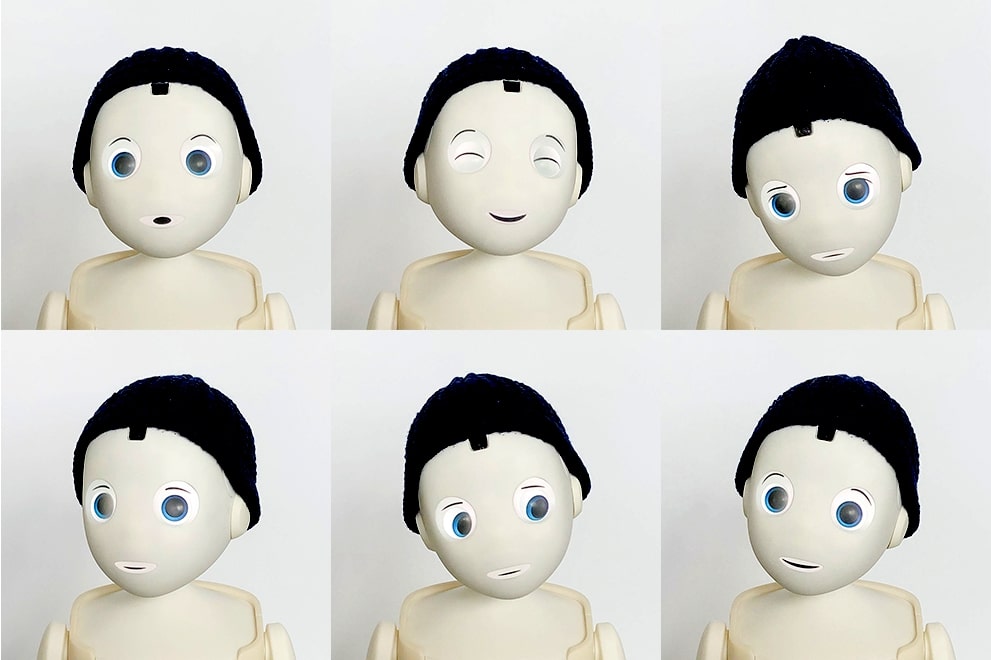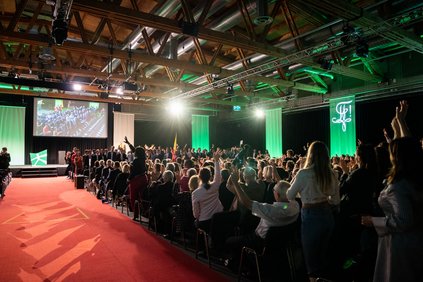Campus - 21.11.2023 - 08:40
Social robot welcomes visitors to SQUARE
HSG computer science students are programming a robot that will serve as an information centre for visitors to SQUARE. HSG students and researchers will continuously observe the robot and interview users. In this way, the robot's behaviour will be optimised, with the long-term aim of the robot being able to move around SQUARE autonomously.

SQUARE covers an area of around 7000 square metres and its rooms are arranged in a grid on three open-plan floors. This can be confusing for visitors looking to attend a particular lecture/seminar. From mid-December, a social robot (pictured above) from Navel Robotics, programmed by students in the Masters in Computer Science, will be on the move.
"The robot will answer visitors' and students' questions in English and help them book group rooms," says HSG master's student Atilla Güven. Together with Phil Natter, he will be programming the 72-centimetre tall, eight-kilogram robot, which has a childlike, friendly face, for SQUARE's needs. The two students will spend several weeks observing and optimising the robot's behaviour; work that they are carrying out as part of a practical project as part of their studies.
First use of the robot in a public building
The aim is to make the robot's behaviour and conversations appear as natural as possible and thus inspire confidence in the user. Out of the box, the robot can read 15 human emotions from faces and respond with different facial expressions and utterances. Güven and Natter are currently programming conversation sequences in SQUARE based on local conditions. "We also want to integrate the AI chatbot ChatGPT. This will allow the robot to react flexibly to unforeseen conversations and questions".
In the long term, it is conceivable that the robot will be able to move around SQUARE completely autonomously, thanks to its cameras and sensors. "Initially, however, it will have to be remotely controlled. SQUARE is very dynamic, there are lots of people moving around and the layout is constantly changing. The robot is not yet programmed for this kind of environment," says Güven. For example, it is still unclear whether and how the robot will be able to use the lift autonomously and whether it will be able to detect steps early on.
Navel Robotics has developed the robot for use in the service sector or in care homes, where it interacts with residents. SQUARE will be the first time the robot is used in a public building. "We will therefore also engage in an academic exchange with the manufacturer and pass on our experience. This will enable them to expand the robot's programming if necessary," says Güven.
Coordination of further functions planned
Researchers at the HSG's School of Computer Science are also interested in how the Navel robot performs and how people react to it. PhD students Yu Sun and Annika Kaltenhauser and Johannes Schöning, HSG professor of Human-Computer Interaction, who are supervising the master's students' current project, will continue to observe the robot as part of their research and ask users about their experiences.
"Robots like the one in SQUARE have a lot of potential," says Yu Sun. "For example, they can support elderly people at home, serve as learning aids in schools, or be available to answer questions in public spaces." At the HSG School of Computer Science, Johannes Schöning's Human-Computer Interaction research group focuses on the interplay between human needs and technology design - for example, how people perceive a robot and its functions.
The robot will remain at SQUARE for the long term. During the test phase, students and other interested parties can use the robot's Instagram profile to make suggestions for additional features. "For example, it could give guided tours of the entire building, display the bus schedule, or give explanations about the art on display," says Güven.
More articles from the same category
This could also be of interest to you
Discover our special topics








![[Translate to English:] KI-Regulierung in der Schweiz | unisg.ch](https://www.unisg.ch/fileadmin/_processed_/2/f/csm_KI_AdobeStock_ipopba-2000x1125_6af0ce2f92.jpg)






